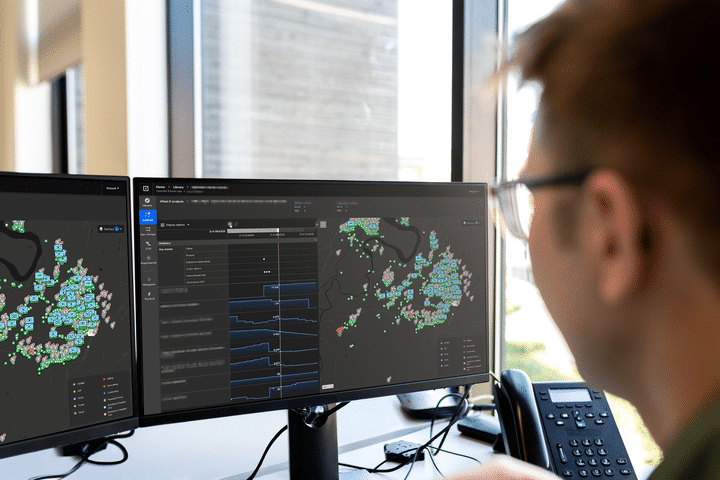
Artificial intelligence from Improbable is being used to further develop the security and defence sectors.
The rise of deep neural networks has contributed vast quantities of classified, annotated and labelled information from disparate raw data. The result is an abundance of AI-generated information sources available for advanced processing.
Leading experts have begun to deepen the neural nets (NNs) with more advanced maths and algorithms to process intelligence from these novel information sources to create a more targeted and explainable AI that learns faster, utilising refined data and fewer resources.
We are starting to see a unification of what were once isolated pools of AI being used to address small but important topics, such as the classification of targets in satellite imagery or to spot the fraudulent use of credit cards. Over time, the areas of use have grown broader and are now starting to converge; the same is happening in the civilian world, particularly with the proliferation of digital twins.
We are seeing a definitive shift from highly specialised, specific applications of AI to more generalised ones which have significantly more use cases. This requires us to adopt a common language to enable interoperability between these emerging technologies. We are reaching a tipping point where we have accumulated sufficient labelled and classified data density to use AI for advanced reasoning. Over the next few years we may witness the development of a more advanced AI, such as hierarchical pyramid structures, in which each layer abstracts from the layer below it.
Adding more advanced mathematical topologies and AI reasoning algorithms can challenge how we view and reason the world and each other – and, it may very well impact our ethical and moral standards. This opens up opportunities in the defence sector, the full extent of which cannot yet be fully fathomed.
Quality intelligence is gradually becoming a more and more accessible resource to leaders across the world. This intelligence will allow for greater insight into the nature of local or even global conflicts, improving the effectiveness of measures employed to increase overall operational stability. An ongoing increase in practical decision-making support facilitates evidence-based, explainable and documented decisions, which will enable future-proof Course of Action (CoA) planning withstanding even the highest standards of scrutiny.
The advantages of synthetic environments
As we move further into the information age, the speed of change will continue to increase. Therefore, those with the ability to adapt training and systems quickly, enabling their synthetic solutions to keep up with the changing battlefield environment, will have an operational advantage.
In particular, synthetic environments as part of a wider platform can enable defence to leverage existing content across organisations and reduce the barrier to developing and testing new technologies in the field.
Accessibility to a wide range of hyper-realistic simulations reduces risk, both within a training scenario and in a real world operation; this is primarily because users have access to a greater variety of choices up and down the application development stack. Moreover, it means that the potential to test new operating systems, languages and tools can lead to a significant amount of performance improvement through consistent mission rehearsal.
The lack of interoperability across UK agencies and allied armed forces has always been a significant issue. Progress is being made with plug-and-play synthetic environments which have cloud-based, open architectures at their heart to enable interoperability – this would allow hundreds or thousands of users to experience and work in a single scenario at the same time, increasing their ability to undertake joint and multi-domain training with multiple forces and agencies.
By enabling faster decision-making, reducing technical and delivery risk and enhancing interoperability, synthetic environments can deliver quantitative benefits for defence and security services across the board, and the use of sophisticated AI technology lies at its heart.
Incorporating AI in the defence sector
At Improbable, we believe that there is a need to distinguish between two major lines of development – technological trends on one hand and usage as well as application on the other. Over the last decade, technology has made huge steps forward.
Improbable uses AI to create content for lifelike synthetic environments and to animate non-player characters within those synthetic environments (creating realistic human behaviours). Improbable’s digital engine can also explain the outputs of synthetic environments and control these synthetic environments to seek out and identify improved tactics and designs.
AI is also used to optimise the performance of our platform, allowing for seamless operation in data-intensive scenarios.
With a well-established pedigree in the gaming industry, Improbable is now taking this expertise into the defence sector where innovative games, AI, modelling and data analytics technologies can be adapted and deployed to deliver a wide range of security and military capabilities.
As a company devoted to metaverse progression, Improbable Defence specialises in building transformative synthetic environments and digital twins that provide the digital backbone for a fully integrated digital ecosystem.
Specifically, Improbable’s synthetic environments create hyper-realistic and complex cross-domain scenarios for training and performance improvement purposes. At the same time, the digital twin replicates processes to allow users to perform network upgrades, enhance service operations and increase resilience, all whilst enabling faster data-based decision making.
Demand for such capability is growing as the UK Strategic Command continues to promote multi-domain integration across all services of the British Armed Forces. To support the new operating model, Improbable Defence has stepped up and is working with the MoD’s Strategic Command to develop a Defence Synthetic Environment Platform (DSEP), a dynamic digital engine enabling military decision-making and cross-government contingency planning through next-generation realistic training scenarios.
In collaboration with the UK Ministry of Defence, Improbable is also developing a Next-Generation Communications Network (NGCN) Digital Twin of its global digital and IT infrastructure.
To find out more information about the work that Improbable is doing in the security and defence sectors, visit: https://defence.improbable.io/
This article was originally published in the March edition of Security Journal UK. To read your FREE digital edition, click here.
